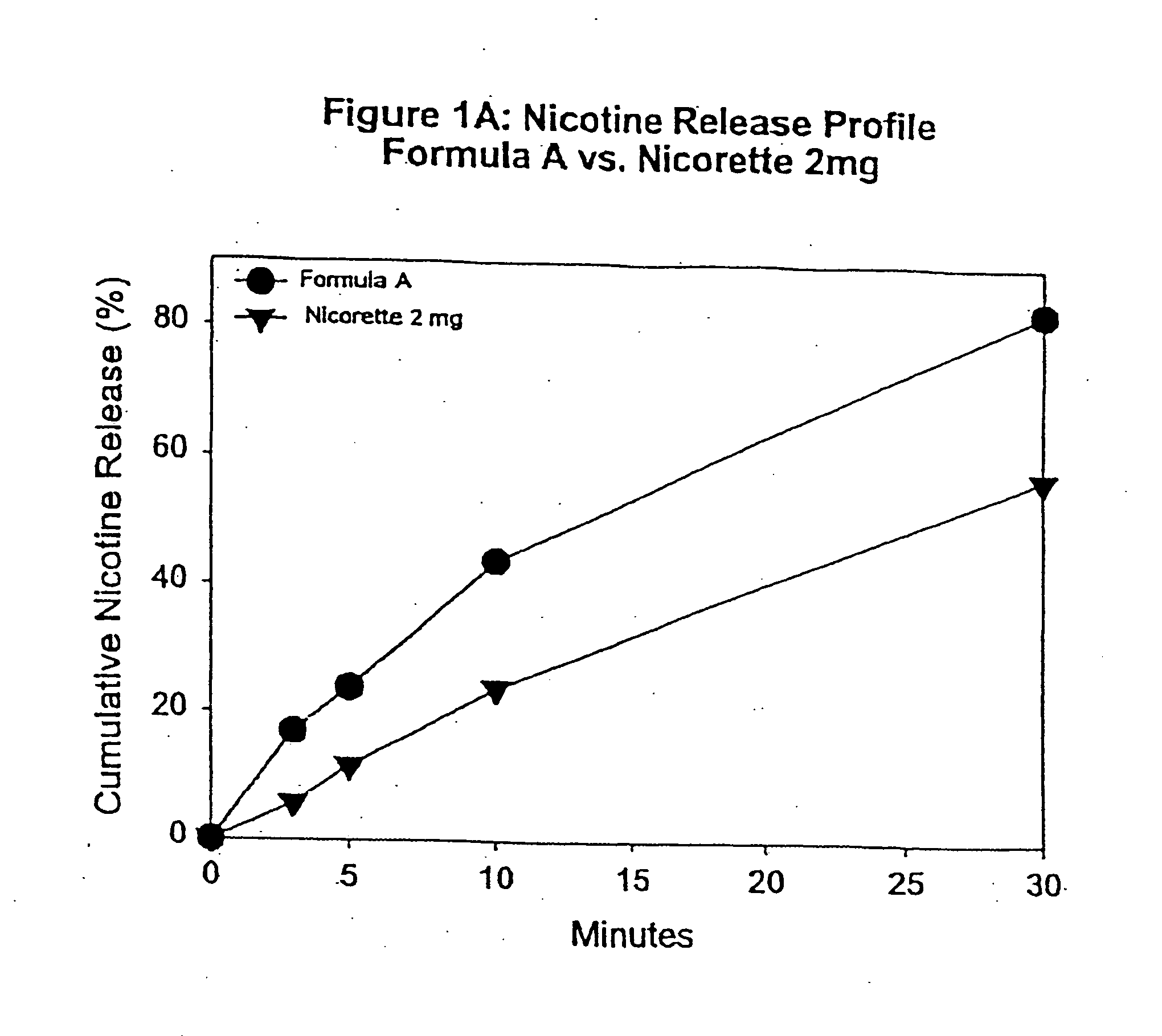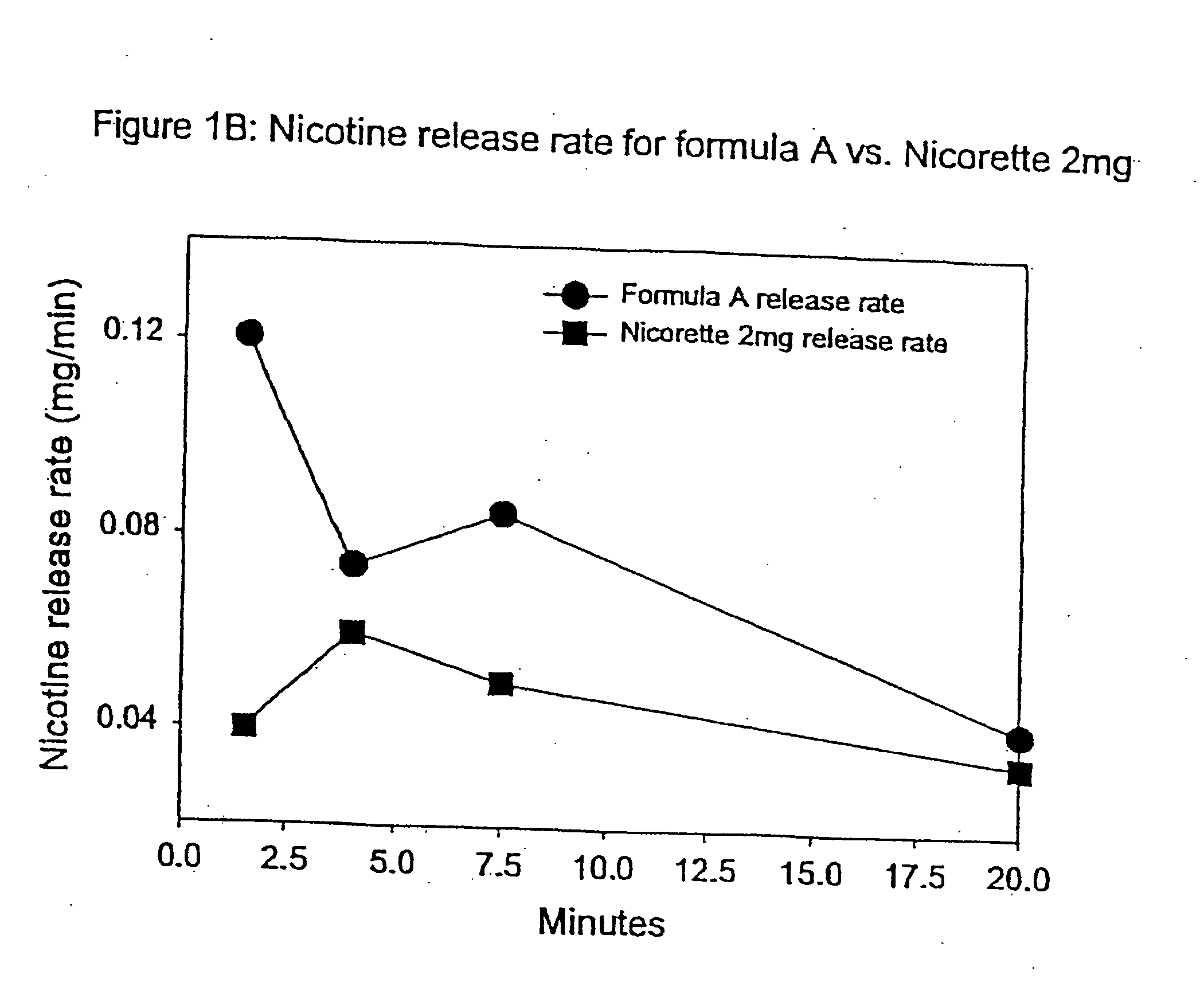Medicated chewing gum delivery system for nicotine
a nicotine chewing gum and delivery system technology, applied in chewing gum, heterocyclic compound active ingredients, inorganic non-active ingredients, etc., can solve the problems of inadequate patient dosing, insufficient absorbed active into the bloodstream for effective therapeutic or pharmacological action, and inability to deliver medicament or active in the appropriate manner. , to achieve the effect of fast relief of symptoms
- Summary
- Abstract
- Description
- Claims
- Application Information
AI Technical Summary
Benefits of technology
Problems solved by technology
Method used
Image
Examples
example 1
[0093] In this example, chew out studies were conducted with five human subjects using Formula A according to one embodiment of the invention, and 2 mg NICORETTE gum. Formula A contained nicotine hydrogen tartrate (approximately 2.2 mg of nicotine base). In addition, the delivery system of Formula A was buffered with 45 mg of potassium carbonate. More specifically, Formula A included GUM BASE X in an amount by weight of about 55%, GUM BASE Y in an amount by weight of about 4.5%, nicotine in ENCAPSULATION FORM I in an amount by weight of about 5%, Sorbitol (NEOSROB P 60 W) in an amount by weight of about 28%, potassium carbonate USP (extra fine) in an amount by weight of about 4.5%, mint flavor in an amount by weight of about 2.4%, and AF menthol in an amount by weight of about 0.6%. In addition, talc USP (e.g, MP98-30) was added as a processing aid in an amount by weight substantially equal to the amount of menthol.
[0094] The percentage of nicotine released is shown in FIG. 1A. As ...
example 2
[0096] In this example, chew out studies were conducted with five human subjects using Formula B according to another embodiment of the invention and compared to 2 mg NICORETTE gum Formula B contained nicotine polacrilex (approximately 2 mg of nicotine base). More specifically, Formula B included GUM BASE X in an amount by weight of about 55%, sorbitol NEOSORB P 60W in an amount by weight of about 22.27%, xylitol CM 90 in an amount by weight of about 16%, a flavoring substance in an amount by weight of about 2.5%, nicotine polacrilex in an amount by weight of about 1.23%, potassium carbonate in an amount by weight of about 2%, and potassium bicarbonate in an amount by weight of about 1%.
[0097] Each serving of the delivery system of Formula B was buffered with a combination of 20 mg of potassium carbonate and 10 mg of potassium bicarbonate. As can be seen from FIG. 2, the NICORETTE formulation released its nicotine quite slowly over the entire 30 minute period. Formula B, on the oth...
example 3
[0098] In this example, the pH of saliva during chewing was measured during the chew out period (20 chews / minute) for five formulations, namely, Formula C, Formula D, Formula E, Formula F, and Formula G. Formula C included GUM BASE X in an amount by weight of about 55%, Sorbitol (NEOSORB P 60 W) in an amount by weight of about 17%, Xylitol milled USP VCC in an amount by weight of about 16%, a buffering system of potassium carbonate USP (extra fine) in an amount by weight of about 4.5%, nicotine in hydrophilic ENCAPSULATION FORM III in an amount by weight of about 5%, and cooling mint flavor in an amount by weight of about 2.5%.
[0099] Formulas C, D, E, and F were identical, except that the buffering systems consisted of the following: Formula C, 45 mg of potassium carbonate (4.5% by weight); Formula D, 30 mg of potassium carbonate (3.0% by weight) and 15 mg of potassium bicarbonate (1.5% by weight); Formula E, 15 mg of potassium carbonate (1.5% by weight) and 30 mg of potassium bica...
PUM
| Property | Measurement | Unit |
|---|---|---|
| concentration | aaaaa | aaaaa |
| weight | aaaaa | aaaaa |
| concentration | aaaaa | aaaaa |
Abstract
Description
Claims
Application Information
 Login to View More
Login to View More - R&D
- Intellectual Property
- Life Sciences
- Materials
- Tech Scout
- Unparalleled Data Quality
- Higher Quality Content
- 60% Fewer Hallucinations
Browse by: Latest US Patents, China's latest patents, Technical Efficacy Thesaurus, Application Domain, Technology Topic, Popular Technical Reports.
© 2025 PatSnap. All rights reserved.Legal|Privacy policy|Modern Slavery Act Transparency Statement|Sitemap|About US| Contact US: help@patsnap.com



